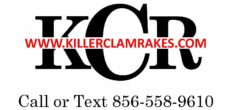East Coast Clamming Rules and Regulations
Below are links for clamming and crabbing laws for each state. Please verify the information with your locality.
If you find a link that is out of date or wrong, please e-mail and let us know.
Connecticut
Recreational shellfishing (or clamming or clam digging) in Connecticut is limited to approved areas. People shellfishing for recreation should contact the town health department where they wish to fish to find out where shellfishing is allowed, whether a local license is required, and other local shellfishing laws.
Connecticut Shellfishing and clamming places, rules, equipment.
Delaware
Minimum size: It shall be unlawful for any person to possess hard clams taken from the waters under the jurisdiction of the State which measure less than 1 1/2 inches.
Delaware Recreational Fishing, Clamming and Crabbing Regulations
Delaware Fishing and Clamming Maps
Florida
Allowable shellfish (oysters, clams, mussels) harvesting areas are established and managed for public health purposes by the Florida Department of Agriculture and Consumer Services, Division of Aquaculture. Two species of hard clam are found in Florida: the northern quahog (Mercenaria mercenaria) and the southern quahog (Mercenaria campechiensis).
Florida Recreational Shellfish Harvesting
Georgia
Saltwaters may be opened for taking shellfish between January 1 and December 31. Prior to harvesting any shellfish, check with the DNR-Coastal Resources Division (www.CoastalGADNR.org) for any seasonal closures that may be in effect during the calendar year. Shellfish must be harvested between the hours of ½ hour before official sunrise and ½ hour after official sunset.
Approved Recreational Harvest Areas
Shrimp, Crab, Shellfish & Bait Minnows
Maryland
Maryland’s Chesapeake Bay waters have long been known for their plentiful shellfish. To protect this valuable resource and safeguard public health the Maryland Department of the Environment is responsible for regulating shellfish harvesting waters. Shellfish include clams, oysters, and mussels. The term shellfish does not include crabs, lobsters, or shrimp. Shellfish are filter-feeding animals: they strain the surrounding water through their gills which trap and transfer food particles to their digestive tract.It is mandatory for oysters and clams to be harvested from approved (open) shellfish waters only.
Maryland Shellfish Advisory and Maps
New Jersey
New Jersey’s rich marine resources offer an outstanding variety of recreational opportunities for residents and visitors to the state. They also support an important commercial fishery and provide the basis for one of the state’s most important industries – tourism. From blue claws to striped bass, from surf fishing to deep artificial reefs, the division’s management of marine resources provides an incredible range of possibilities for enjoying our coastal areas.
NJ Clamming (not so) Fun Fact: There is no clamming in New Jersey on Sundays except for a few select areas.
Saltwater Fishing, Clamming and Crabbing
New York
State law limits recreational harvest to no more than one bushel (combined total volume) of clams, oysters and mussels per day. In addition, one bushel of bay scallops per day may be taken during the season. No permit is required for recreational shellfish harvesting from state lands. Some local towns have additional restrictions on catch limits, size limits, season, type of gear and may require residency and additional permits. Please contact towns for more information.
Saltwater Fishing and Crabbing
Maine
Maine Coastal Program News
Shellfish Sanitation and Management
General Town Shellfish Information
Massachusetts
Shellfishing (or clamming or clam digging) or for clams, oysters, and mussels, is a traditional coastal activity. In Massachusetts, recreational shellfishing is regulated by the towns. (info)
The Guide: Clam Digging in Massachusetts – Boston Magazine
New Hampshire
A shellfishing license is required to harvest clams or oysters; NH residents only. Resident Softshell Clam and Resident Oyster licenses are available to purchase online.
New Hampshire Shellfish Harvest Areas
North Carolina
There are no official dates for North Carolina’s clamming season. But, the best time to score big is between June and late August when the waters are nice and warm. You do not have to have a license for recreational clamming, but there are laws on the size of clams and quantity you are allowed to harvest.
North Carolina Recreational Shellfish, Crustaceaons and Fish Limits Size and Bag Limits
North Carolina Shellfish Harvesting maps
South Carolina
Recreational harvest of shellfish (clams, oysters and other molluscan bivalves) requires a South Carolina Saltwater Fishing License ($10 resident/$35 nonresident). This license is not required for individuals less than 16 years of age or residents holding a valid Gratis Over 65 or Gratis Disability License.
South Carolina Shellfish Regulations
Rhode Island
Any resident of this State may, without a license, take quahogs, soft-shelled clams, mussels, surf clams, oysters (in season), and bay scallops (in season). Harvested shellfish may not be sold or offered for sale. Holders of a non-resident shellfishing license may take quahogs, soft-shelled clams, mussels, surf clams, oysters (in season).
Rhode Island Shellfish Regulations
Virginia
Virginia Harvesting of Clams Regulations
Virginia Regulations on Shellfish
Canada
Shellfish Harvesting in Canada


